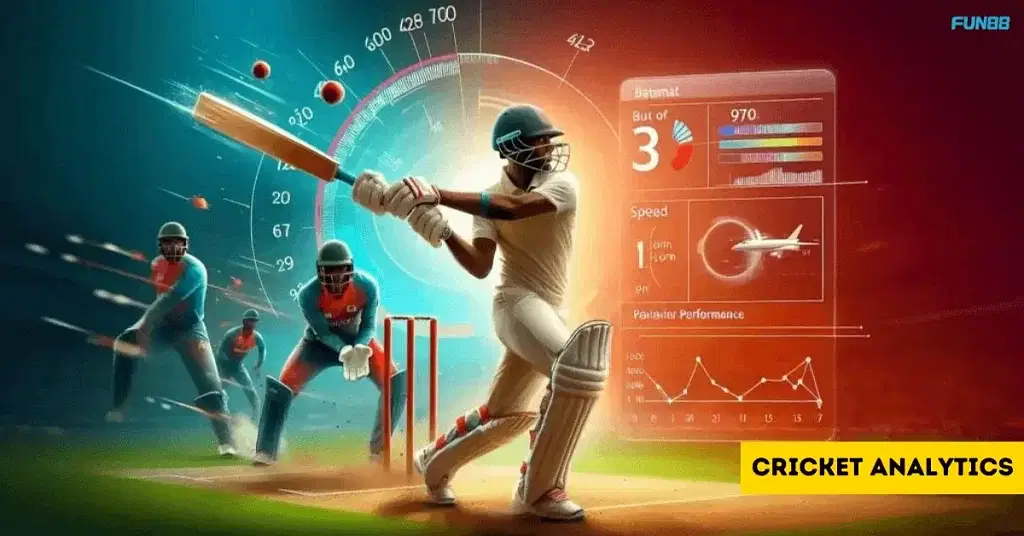Cricket has changed a lot over the years. One significant change is the rise of data analytics. What used to be a game driven by instinct and skill now relies on advanced metrics and data analysis to make better decisions, both on and off the field.
With T20’s growing popularity, using cricket analytics has become vital for teams wanting to stay competitive. It helps them understand the strengths and weaknesses of a team as well as an individual.
This detailed guide will show how data analytics is changing modern Cricket, from team selection to in-game tactics. We’ll look at how teams gather, analyse, and use data to boost performance, improve strategy, and increase their chances of winning.
The Rise of Data Analytics in Cricket
Using data analytics in Cricket is new but super impactful. Cricket has many variables—player performance, weather, pitch type, and match format—so it was always ripe for statistical analysis. But until about twenty years ago, most choices were based on experience and gut feeling.
Technologies like Hawk-Eye, Snickometer, and Spidercam changed how data is collected. When stakeholders (coaches, analysts, team managers) saw the value of data-driven insights, analytics spread from top national teams to franchise leagues and domestic circuits.
The Turning Point: Moneyball and Its Impact
Data analytics received significant attention in 2003 with Michael Lewis’s book Moneyball, which described how Oakland Athletics used sabermetrics in baseball. This inspired cricketers to explore similar ideas. The IPL’s launch in 2008 pushed advanced analytics adoption even further.
Key Areas of Cricket Analytics
Have a look at key areas of cricket analytics:
Batting Analysis
Batting analysis isn’t just averages & strike rates anymore. Today’s cricket analytics dig deeper into things like:
● Shot selection & execution
● Performance against specific bowlers
● Scoring patterns at different game stages
● Ability to rotate the strike
● Handling pressure situations
Advanced metrics, such as batting impact factor and expected runs added, give a more detailed view of a batsman’s role in the team.
Bowling Analysis
Bowling analysis has also grown beyond just counting wickets and economy rates. Focus areas now include:
● Ball-by-ball data online, length & speed
● Effectiveness of variations
● Performance against different batsmen
● Creating pressure through dot balls
● Overall match impact
Metrics such as expected wickets & pressure creation index show a bowler’s real value beyond old stats.
Fielding and Wicketkeeping Analysis
Fielding and wicketkeeping used to get less attention, but not anymore with modern cricket analytics tracking:
● Catches taken/dropped
● Run-outs made
● Fielding positions’ impact on stopping runs
● Stumping chances created/converted
● Overall defensive performance
Advanced cameras & tracking tech let teams measure a player’s fielding contribution more accurately than ever before.
Related Read: Bails in Cricket | What, Why & How of Cricket Bails
The Role of Technology in Data Collection
Tech innovations have been central to the data boom in Cricket. Here are some key tools teams & analysts use to gather data:
● Hawk-Eye Technology: Initially used to track the ball in tennis, Hawk-Eye is now crucial in Cricket. It tracks the ball’s path, helping analysts study line and length, speed, and deviations. This aids bowlers in fine-tuning their strategies and understanding different conditions.
● Player Tracking Systems: GPS vests worn by players offer detailed insights into movements, positioning, speed, and endurance. This assists coaches in evaluating fitness and recovery times to ensure top performance.
● Pitch and Weather Sensors: Sensors on pitches & weather forecasting tools help predict pitch behaviour during a match. Factors like moisture, pitch wear, and wind speed are key for planning bowling tactics and setting goals.
● Bat Sensors: Some teams are testing sensors on bats to measure speed, impact force, and swing angles. This information helps refine batting techniques.
Applications of Data Analytics in Cricket
The use of data analytics in Cricket can be broken down into several key areas. These teams make more informed decisions both before and during matches.
Player Performance Analysis
One major use of data analytics is evaluating individual player performance. Metrics like strike rates, economy rates, dot ball percentages, and conversion rates allow teams to analyse a player’s contributions in detail.
Batting Analytics: Modern data tools let analysts study a batsman’s strengths and weaknesses under different conditions. This includes specific types of bowlers and various match formats. For instance, data might show that a player struggles against left-arm spinners in the middle overs. The opposition can then exploit this weakness.
Bowling Analytics: Data analytics can reveal patterns for bowlers based on pitch conditions, lengths bowled, and match situations. For example, a bowler who often bowls short deliveries in power plays might have a higher chance of conceding runs. This information helps coaches make better tactical adjustments.
Fielding Analytics: Teams now use fielding metrics to gauge how efficient their players are on the field. Positions, reaction times, & throw accuracy are tracked to help teams place fielders in the best positions based on historical data of batters’s tendencies.
Team Selection and Player Recruitment
Cricket analytics is crucial for team selection and recruitment, especially in franchise leagues like IPL & BBL. Instead of just relying on a player’s reputation, teams dig deep into statistics to see how well a player fits their strategy.
For example, data might indicate that a specific player performs better on slow pitches, making him more suitable for certain tournaments. Conversely, teams in countries like Australia might target a player excelling on fast pitches.
Match Strategy and Tactics
Thanks to data analytics, in-game decisions and match strategies have evolved. Coaches and captains use real-time data to tweak strategies as they go along.
Setting Targets: Using historical data helps teams estimate par scores for particular pitches or weather conditions. If it’s shown that chasing teams generally struggle on slow pitches under lights, teams may choose to bat first and set an aggressive target.
Bowling Plans: Bowling data allows for setting specific fielding positions and planning bowling rotations. For instance, if certain batters are more vulnerable to short-pitched deliveries early in the game—this can shape bowling decisions aimed at gaining early wickets.
Batting Orders: Data assists in determining effective batting orders depending on the match situation. Some players excel at building innings under pressure, while others thrive in high-pressure scenarios that require aggressive play. By analysing past performances, teams can customise their batting lineup accordingly.
Also Read: What is a Dot Ball in Cricket? Explanation and Importance
Injury Prevention and Fitness Management
These days, player health and fitness are vital in cricket, especially with demanding multi-format schedules. Data analytics now plays an important role here, too, by aiding injury prevention and managing workloads effectively.
Workload Tracking: By monitoring overs bowled, balls faced, and movements on the field, teams analyse workload levels to decide when players need rest. Overworking fast bowlers could lead to injuries; tracking exertion helps keep them fit throughout long tours.
Recovery Analytics: Recovery patterns are analysed to prepare players for subsequent games. Data including sleep patterns—Like heart rate—and physical exertion records help gauge recovery, ensuring players remain at peak condition.
Impact of Data Analytics on Coaching
Cricket coaching methods have undergone some big changes, thanks to data analytics. Coaches now lean not just on their know-how and instincts but also use data to make smart decisions about helping players improve and planning game strategies.
Performance: Analytics let coaches zero in on where players need to improve. For example, if the data shows that batters struggle with balls aimed at their pads, coaches can design drills to fix that problem.
Opposition analysis: Detailed stats about the other team’s strengths and weaknesses help teams create focused game plans. A coach might target a specific bowler who struggles during the death overs, or they could tell a batsman to attack a particular bowler based on past data.
Match simulation: Using data, coaches set up practice scenarios that mimic real match situations. They analyse the numbers and create training drills to prep players for high-pressure moments, like defending a total in the final overs or chasing a large score in limited-overs games.
Analytics in Franchise Cricket Leagues
Franchise leagues such as the IPL, BBL, and Caribbean Premier League (CPL) are big on using data analytics both for auction strategies & in-game decisions.
Player Auctions and Drafts
These leagues call in expert analysts to guide them with data-driven decisions during player auctions. Analysts look at many factors, including:
● Performance across formats
● Historical data under specific conditions
● Fitness levels and injury background
● Strike rates & economy rates at different stages of the game
For instance, a team might favour a bowler with great stats during powerplay overs over another who has better overall economy but performs less well in critical moments.
Game-Day Strategy
On match days, franchise teams rely heavily on real-time data for making various decisions like bowling changes, field placements, and batting orders. If the numbers suggest that pushing a power hitter up the order will work well against key bowlers from the other team, that’s what they’ll do.
Challenges and Limitations of Cricket Analytics
Have a look at the challenges and limitations of cricket analytics:
Data Quality and Consistency
One big challenge in cricket analytics is making sure data is good and consistent. Things like:
● Different ways of collecting data across tournaments
● Mistakes from humans when entering data by hand
● Changes in pitch & weather conditions
These can mess up how reliable the data is for analysis. People are working to fix these issues.
Balancing Data with Intuition
Data analytics gives great insights, but it’s important to also use cricketing intuition. Experienced players & coaches have knowledge that numbers might miss. The tricky part is mixing analytics with traditional wisdom to make smart decisions.
Ethical Considerations
As cricket analytics gets better, there are ethical issues like:
● Player privacy and who owns the data
● Risks of data being manipulated or misused
● How it affects the spirit of the game
Cricket leaders are creating rules to handle these ethical concerns and make sure data is used responsibly in Cricket.
Also Read: What is Power Play in Cricket? Complete Guide
The Future of Data Analytics in Cricket
The future of cricket analytics looks exciting. With tech getting better, so will tools for gathering and studying data. Some trends that could shape what’s next include:
● AI and Machine Learning: Smart AI could help teams predict player form, match outcomes, and even what might happen during a game before it does.
● Wearable Technology: Better wearables could give real-time details on player fitness, stamina, & biomechanics, which can optimise performance and prevent injuries.
● Fan Engagement: Data isn’t just for teams and players anymore. Fans also engage with it, with platforms offering detailed match stats, player analysis, and prediction models for a deeper look at the game.
Final Word
Data analytics in cricket has changed Cricket a lot. It gives teams useful information to play better and make good choices. As technology keeps growing, data analytics will become even more important in Cricket. The sport will become more data-driven and scientific.
But data alone isn’t enough. Players and coaches need to use it well on the field. Cricket is still about skill and strategy at its core, with data helping out a lot. With ongoing tech progress and loads of new data, we can’t wait to see how Cricket will grow in the years ahead.
Star it if you find it helpful.

